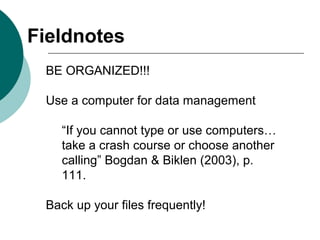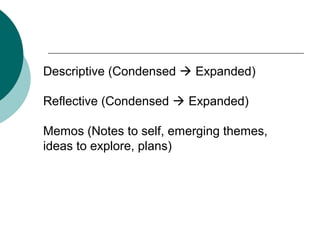Fieldnotes[1] (4)
- 1. BE ORGANIZED!!! Use a computer for data management âIf you cannot type or use computersâĶ take a crash course or choose another callingâ Bogdan & Biklen (2003), p. 111. Back up your files frequently! Fieldnotes
- 2. Use computer file-naming conventions, e.g., 2006_interview_Jones_notes 2006_interview_Jones_transcript 2006_interview_Jones_coded 2006_fieldnotes_original 2006_fieldnotes_expanded 2006_fieldnotes_coded
- 3. Descriptive (Condensed ï Expanded) Reflective (Condensed ï Expanded) Memos (Notes to self, emerging themes, ideas to explore, plans)
- 4. Fieldnote Tips: âĒUse a portable word processor or laptop for fieldnotes âĒWrite fieldnotes immediately, do NOT wait until later âĒStart a new paragraph for every new âepisodeâ âĒOrganize information chronologically âĒDistinguish your reflections in brackets, ALL CAPS, or use some other visual convention âĒLeave large margins for hardcopy coding (or use columns)
- 5. PORTRAITS OF THE PARTICIPANTS This includes their physical appearance, dress, mannerisms, and style of talking and acting. Look for particular aspects of people that might set them apart from others and tell you about their interests and affiliations.
- 6. RECONSTRUCTION OF DIALOGUE The conversations that go on between participants are recorded as well as what participants say to you directly. Strive to capture the participantsâ language, in their own words. Quote the participants. Write down words or phrases that are unique to the setting or that have a special use in the setting.
- 7. DESCRIPTION OF THE PHYSICAL SETTING Drawings of the space and furniture arrangements are useful. Verbal sketches of things such as the contents of bulletin boards, the furniture, the floors, the wallsâ the general feel of the roomâmay also be included. Try to capture the sense of the building or locationâthe context.
- 8. ACCOUNTS OF PARTICULAR EVENTS List who was involved, in what manner, and the nature of the action.
- 9. DEPICTION OF ACTIVITIES Include detailed descriptions of behavior and try to reproduce the sequence of both behaviors and particular acts.
- 10. YOUR BEHAVIOR Treat yourself as an object of scrutiny, too. Because you are the instrument of data collection, it is very important to take stock of your own behavior, assumptions, and whatever else might affect the data that are gathered and analyzed.
- 11. REFLECTIVE FIELDNOTES Reflections on analysis Reflections on method Reflections on ethical dilemmas and conflicts Reflections on the observerâs frame of mind Points of clarification










